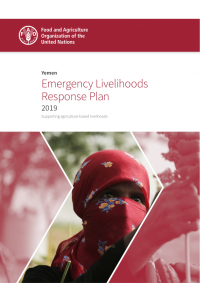Yemen Emergency Livelihoods Response Plan 2019
2018 in review
to support 3.1 million people
USD 52 million mobilized in 2018
As of January 2019, the 2018 Yemen Humanitarian Response Plan (HRP) was 86.9 percent funded against the requested USD 2.96 billion – the largest proportion of which was used to fund food security and agriculture (mainly food assistance), health, nutrition and protection cluster-related interventions. The focus was mainly on life-saving, protection as well as provision of essential services and livelihoods support in the most severely affected districts and governorates through an integrated response approach.
Within the same period, the Food and Agriculture Organization of the United Nations (FAO) mobilized USD 52 million to provide agricultural livelihood inputs and services to more than 436 465 most vulnerable and food insecure households (3.1 million people).
It has been recognized that without the integrated massive humanitarian support provided to the most vulnerable households in the most severely affected districts and governorates, famine would not have been prevented.
In 2019, addressing key drivers of food insecurity and malnutrition will be crucial, vulnerability factors that compounded the current situation should be addressed, especially given that the conflict has become protracted in nature.
Overview
to assist 7 million people
FAO requires USD 135 million
period January–December 2019
Yemen is the world’s largest humanitarian crisis where the population faces constant threats to their lives and livelihoods. The ongoing conflict has led to a severe economic decline and collapsed essential services, taking an enormous toll on the population and exacerbating existing vulnerabilities. The expansion of the conflict has also led to large-scale displacements and high rates of malnutrition.
Based on the Integrated Food Security Phase Classification (IPC) analysis in December 2018, 151 districts out of 333 would likely be in a more severe phase in the absence of Humanitarian Food Assistance. Food assistance is currently reaching 30 percent of households in Yemen and is considered an important primary source of food. It is estimated that, in the absence of the mitigating effects of humanitarian food assistance, the population in need of urgent action (IPC Phase 3 and above) would reach 20 million (67 percent of total population) including 240 000 (1 percent) in Catastrophe (IPC Phase 5), 32 percent (9.6 million) in Emergency (IPC Phase 4) and 34 percent (10 million) in Crisis (IPC Phase 3).
In response, FAO developed the Yemen Emergency Livelihoods Response Plan (ELRP) 2019. This plan guides FAO’s response to prevent the levels of food insecurity and malnutrition from worsening. It sets out key emergency agricultural livelihood interventions to be implemented within the framework of the 2019 HRP. The ELRP was prepared after an extensive analysis of the drivers of food insecurity and malnutrition in Yemen, a thorough review of various assessment reports, and discussions with FAO technical staff, relevant government line ministries and local authorities.
The overall objective of the plan is to accelerate livelihoods recovery for sustained food security and income opportunities for the most vulnerable households through improved availability and access to food, economic empowerment, agricultural infrastructure improvement, capacity development and effective coordination of interventions. Implementing the ELRP will require USD 135 million to support 990 900 households (7 million people) over a 12-month period in the districts with high levels of food insecurity as classified by the IPC.
https://reliefweb.int/report/yemen/yemen-emergency-livelihoods-response-plan-2019


